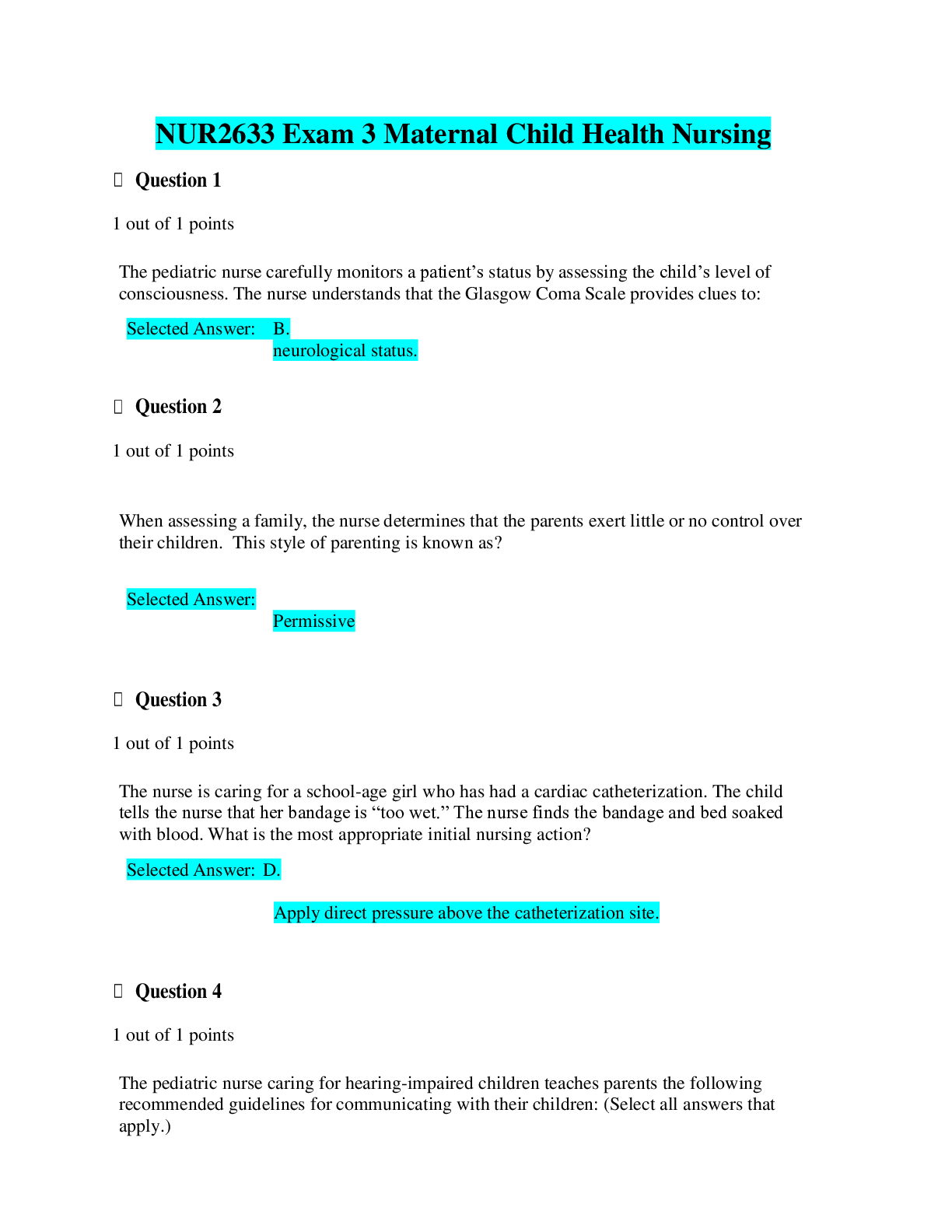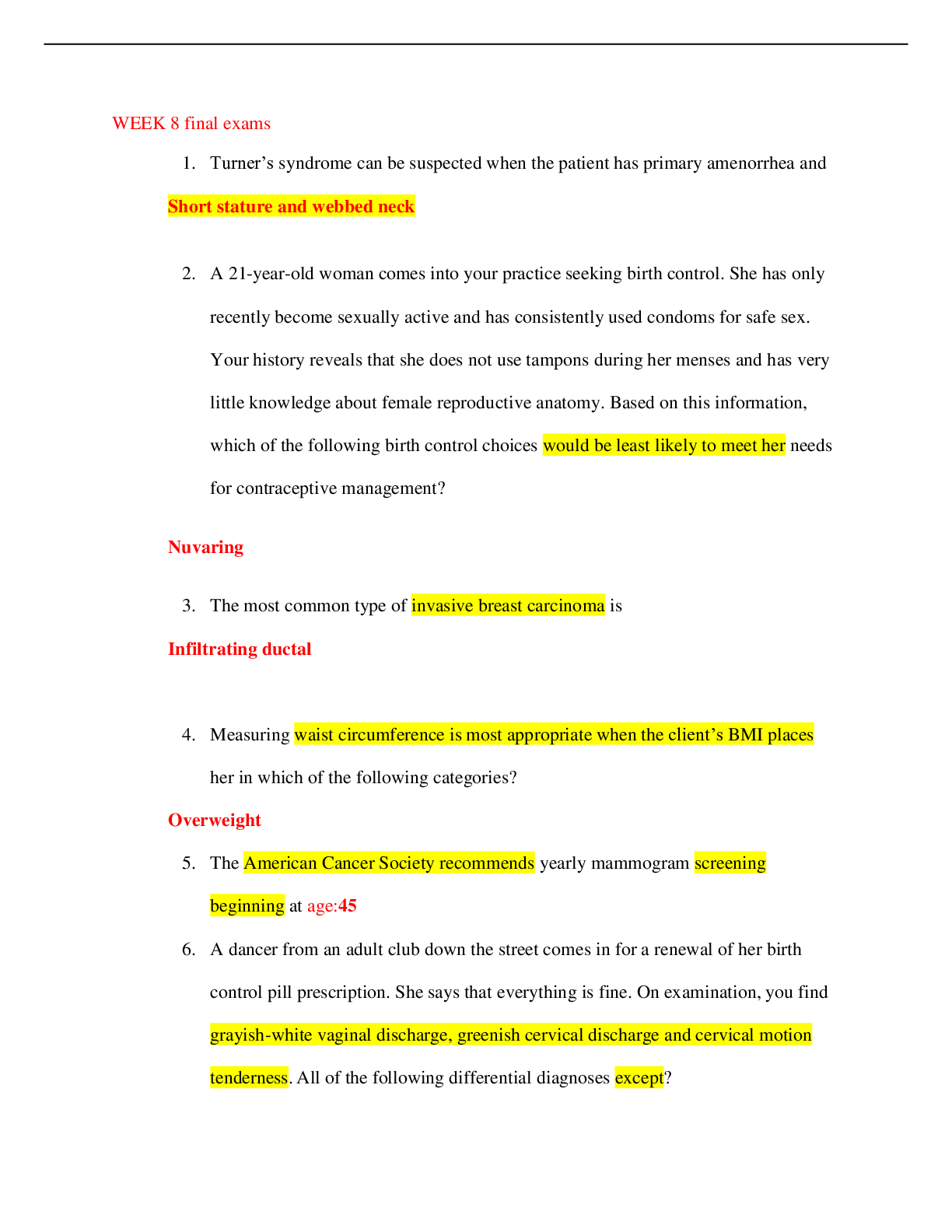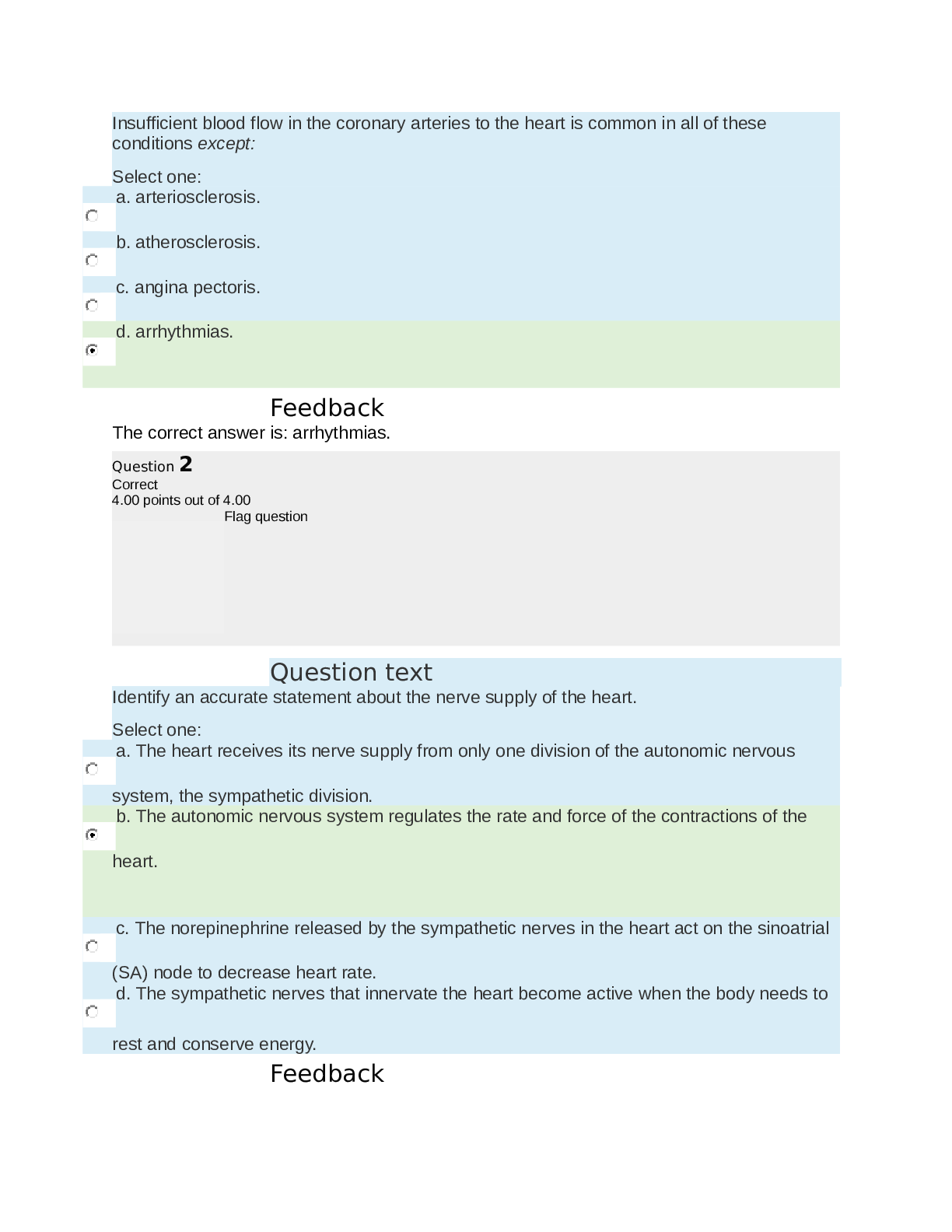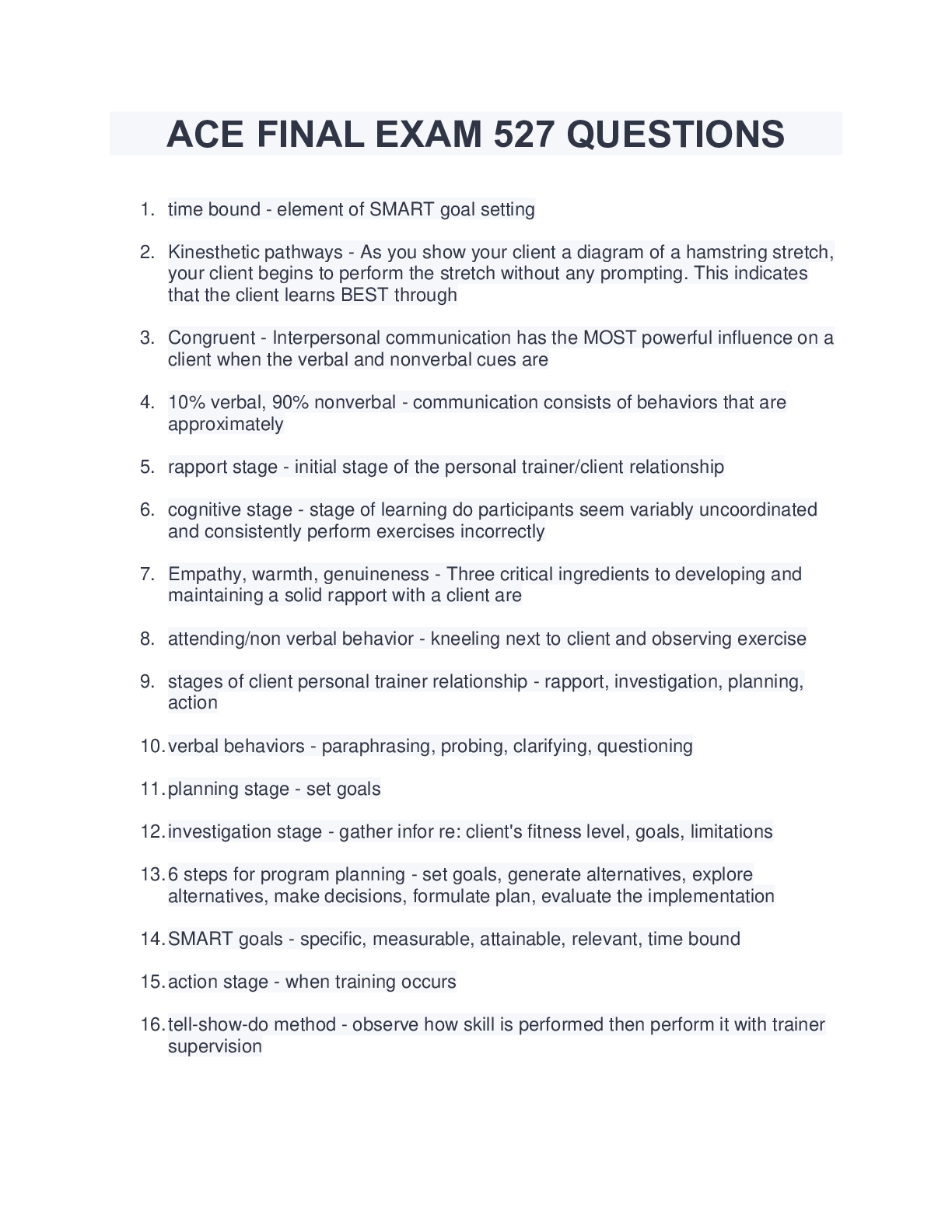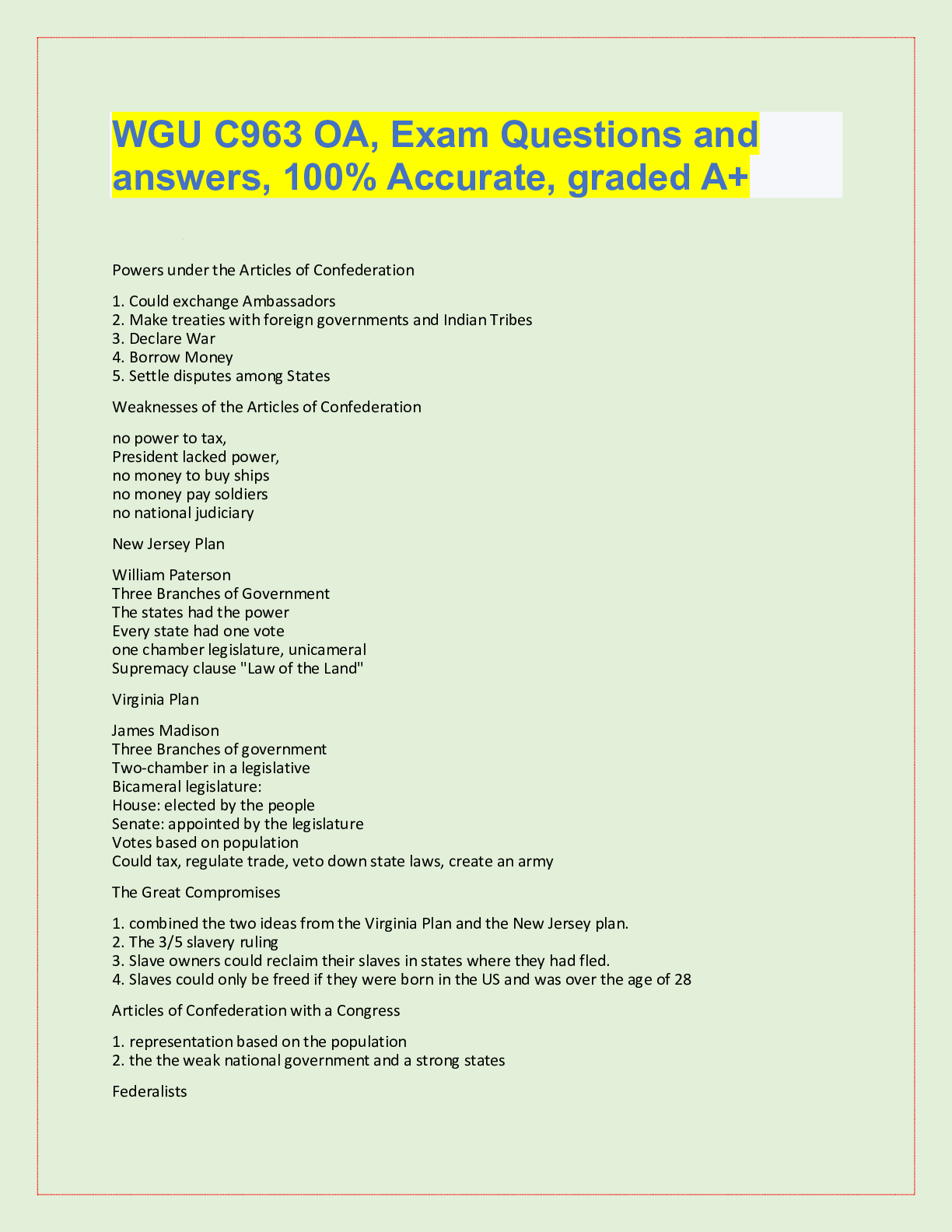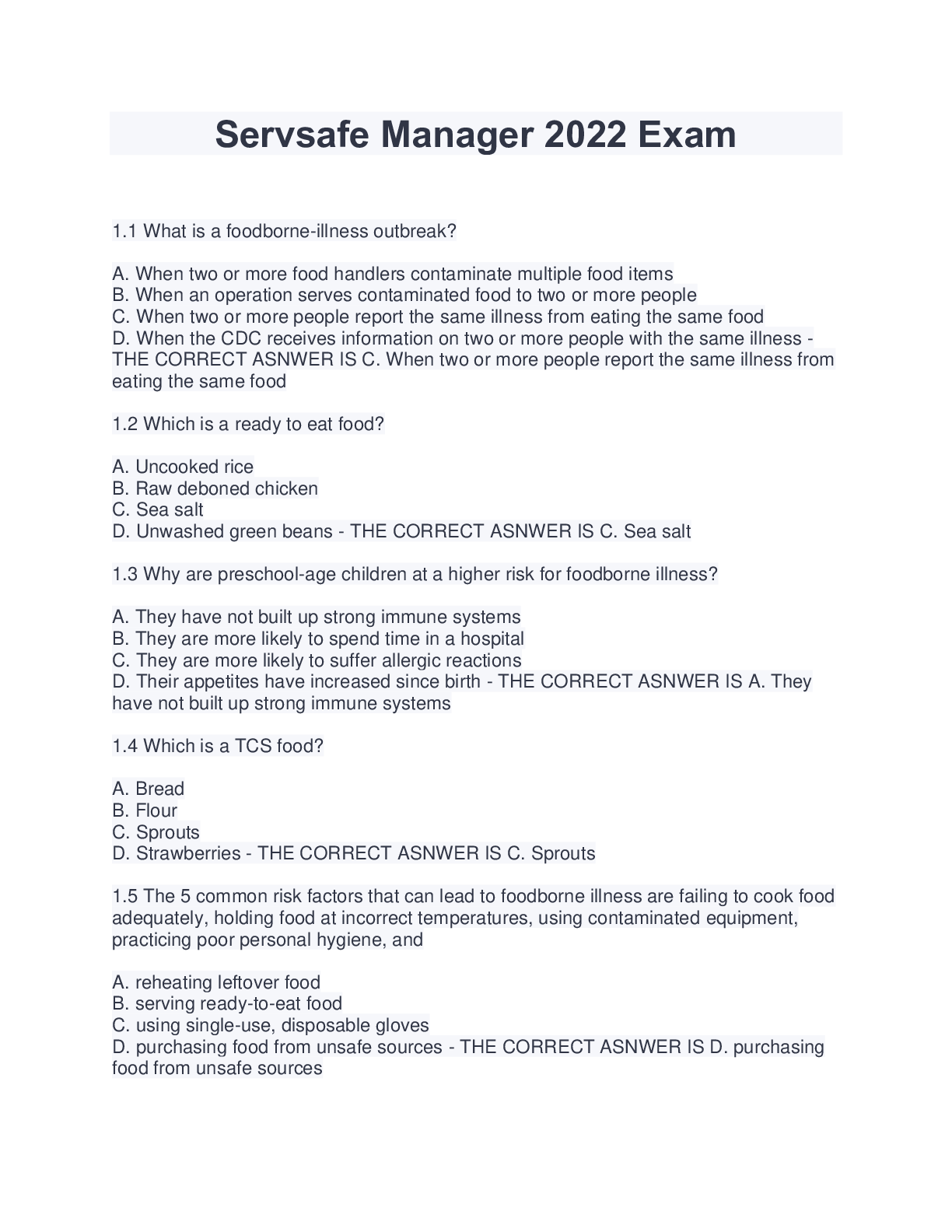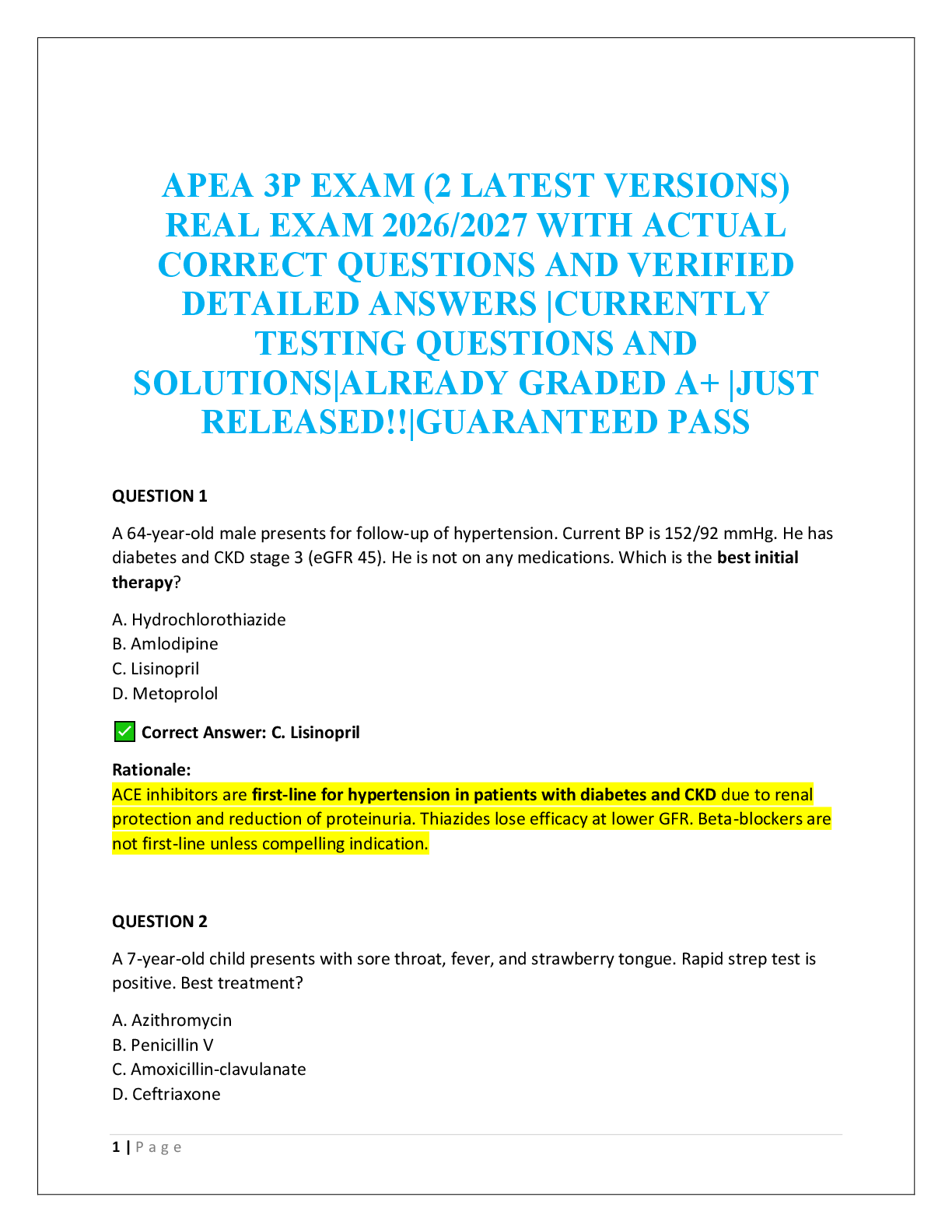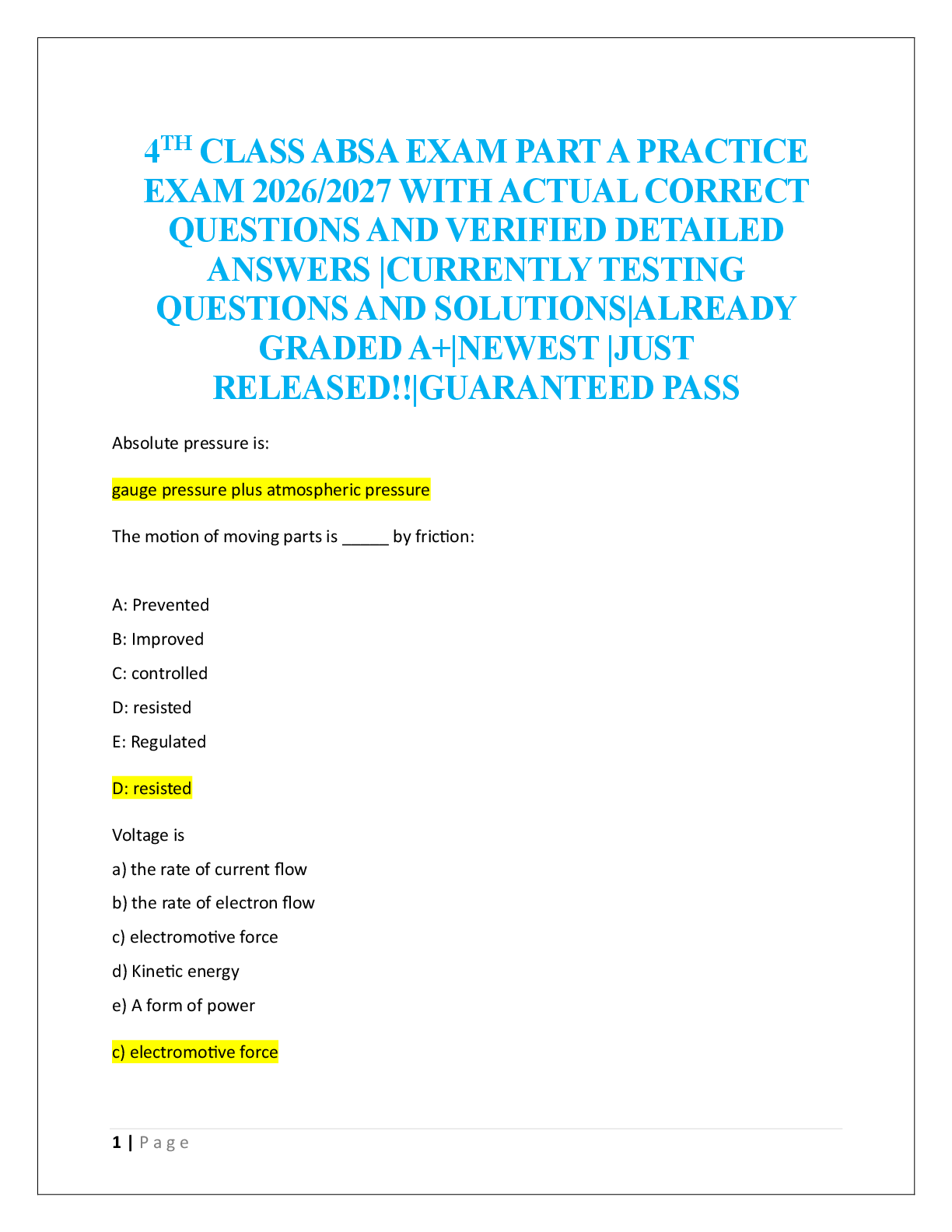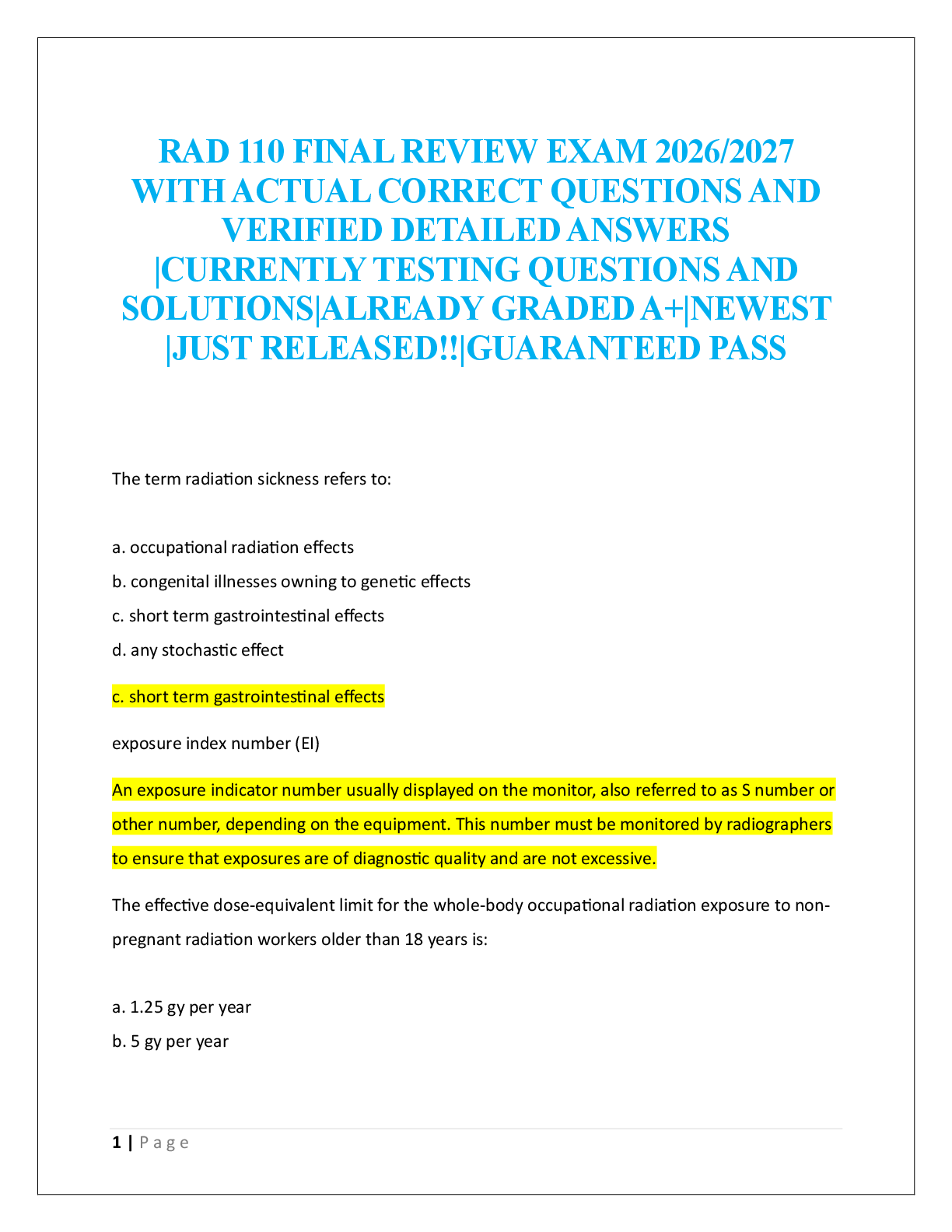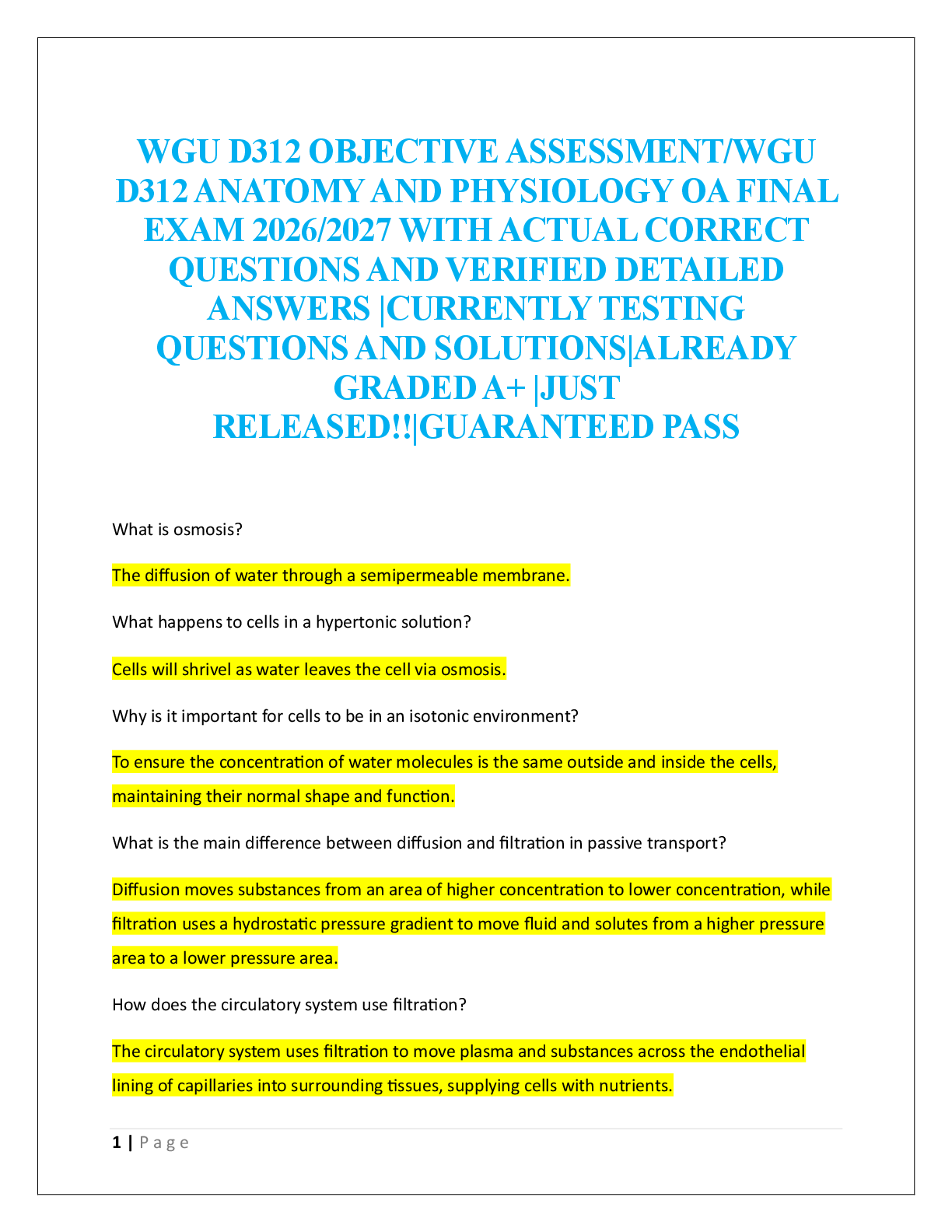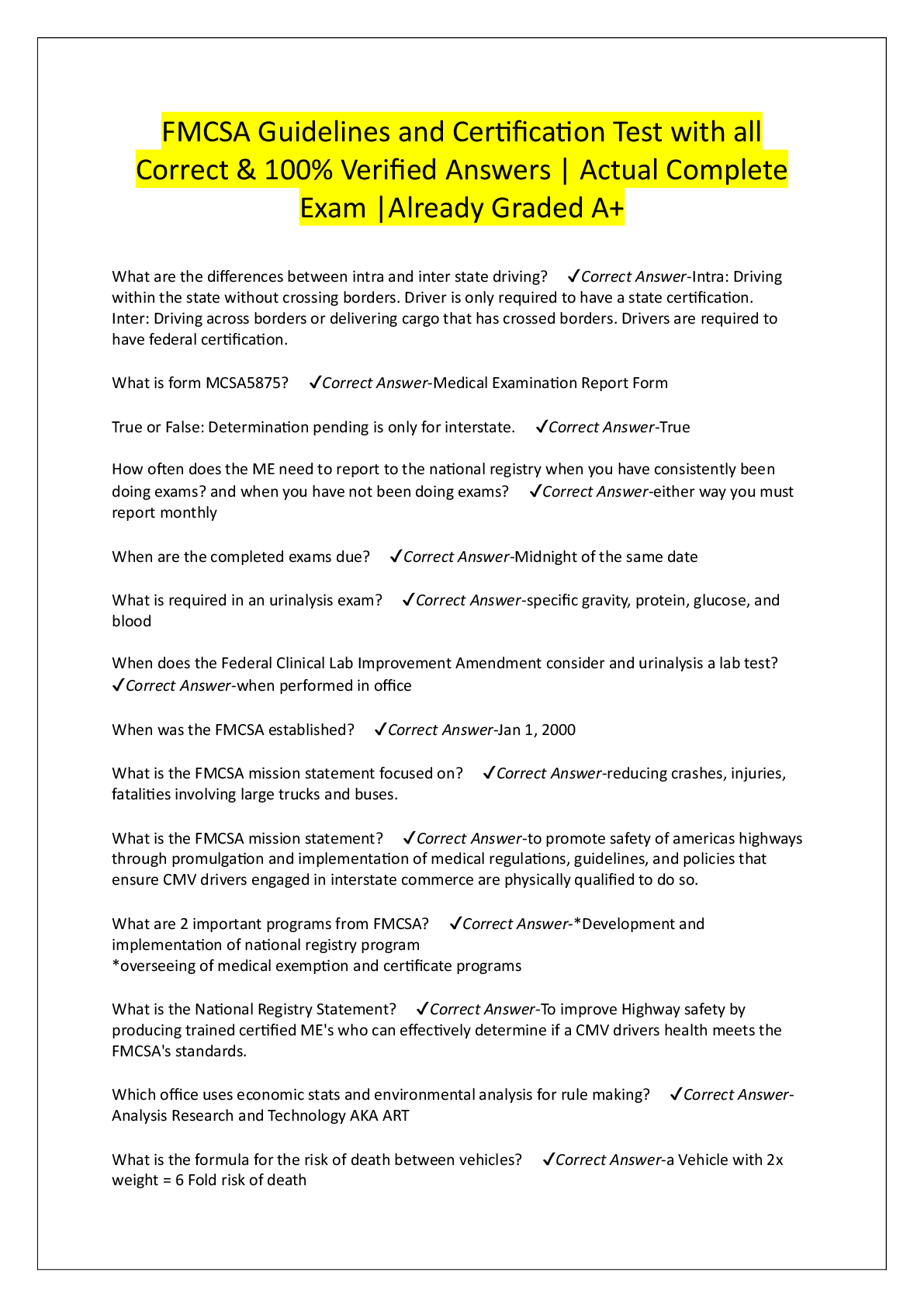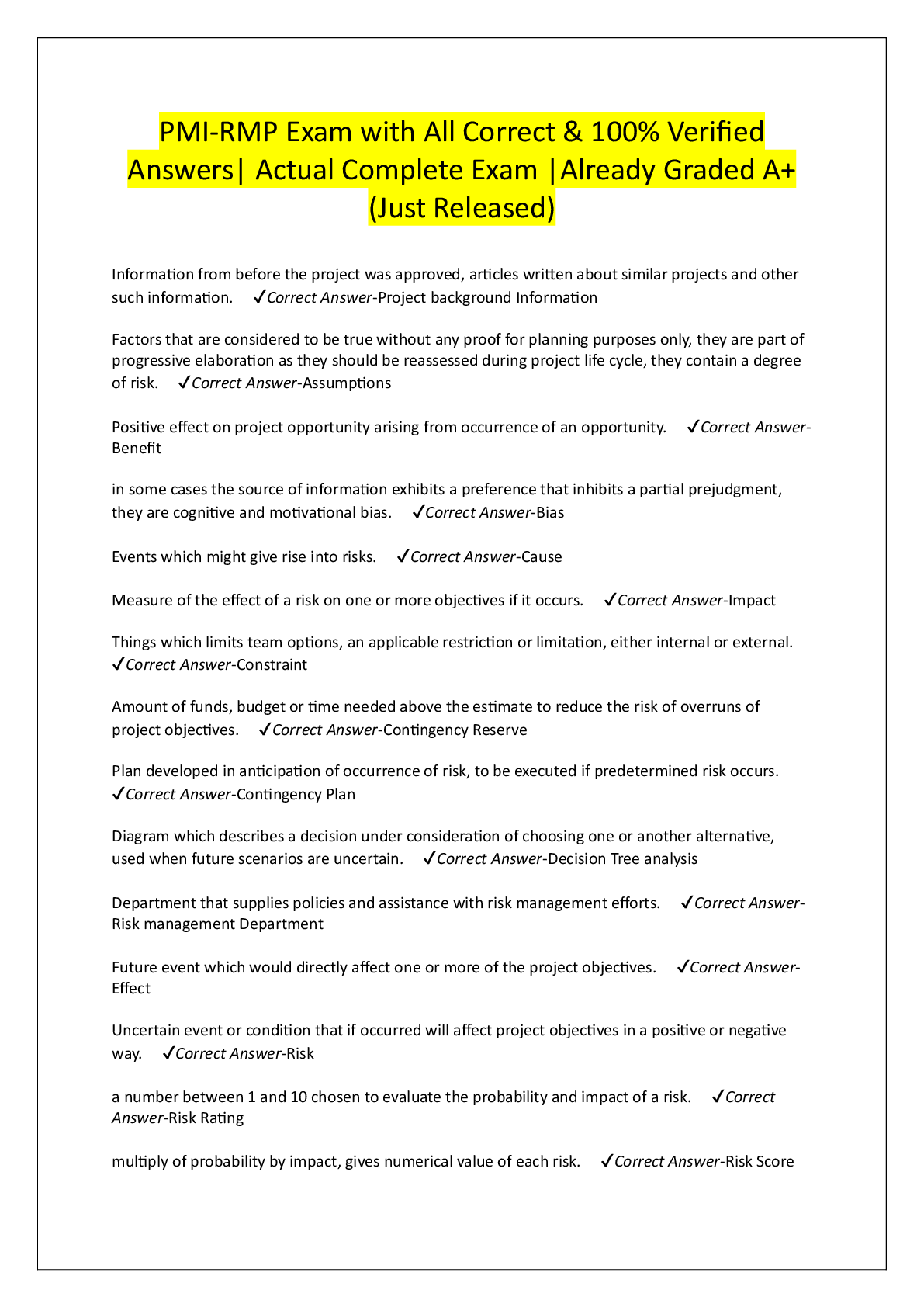NR 507 Week 6 Quiz (2 Versions) / NR507 Week 6 Quiz (Latest-2021): Advanced Pathophysiology: Chamberlain College of Nursing |100% Correct Answers, Download to Score A|
Document Content and Description Below
NR 507 Week 6 Quiz (2 Versions) / NR507 Week 6 Quiz (Latest-2021): Advanced Pathophysiology: Chamberlain College of Nursing |100% Correct Answers, Download to Score A|
1. Question : A(n) _____ fractu
...
re is a fracture at a site of a preexisting bone abnormality, usually by a force that would not normally cause a fracture.
Student Answer: idiopathic
incomplete
pathologic
greenstick
Instructor Explanation: A pathologic fracture is a break at the site of a preexisting abnormality, usually by force that would not fracture a normal bone.
Points Received: 2 of 2
Comments:
Question 2. Question : Which of the following attaches skeletal muscle to bone?
Student Answer: Tendon
Ligament
Bursa
Mesentery
Instructor Explanation: A tendon is fibrous connective tissue that attaches skeletal muscle to bone.
Points Received: 2 of 2
Comments:
Question 3. Question : _____ is the temporary displacement of two bones in which the bone surfaces partially lose contact.
Student Answer: Dislocation
Subluxation
Malunion
Nonunion
Instructor Explanation: Dislocation is the temporary displacement of a bone from its normal position in a joint. If the contact between the two surfaces is only partially lost, the injury is called a subluxation.
Points Received: 2 of 2
Comments:
Question 4. Question : Which disorder is characterized by the formation of abnormal new bone at an accelerated rate beginning with excessive resorption of spongy bone?
Student Answer: Osteomalacia
Paget disease
Osteoporosis
Osteosarcoma
Instructor Explanation: Paget disease (osteitis deformans) is a state of increased metabolic activity in bone characterized by abnormal and excessive bone remodeling, both resorption and formation. Chronic accelerated remodeling eventually enlarges and softens the affected bones.
Points Received: 2 of 2
Comments:
Question 5. Question : What causes the crystallization within the synovial fluid of the joint affected by gouty arthritis?
Student Answer: Reduced excretion of purines
Overproduction of uric acid
Increase in the glycosaminoglycan levels
Overproduction of proteoglycans
Instructor Explanation: When the uric acid reaches a certain concentration in fluids, it crystallizes, forming insoluble precipitates that are deposited in connective tissues throughout the body. Crystallization in synovial fluid causes acute, painful inflammation of the joint, which is a condition known as gouty arthritis.
Points Received: 2 of 2
Comments:
Question 6. Question : Rhabdomyolysis is characterized by
Student Answer: paralysis of skeletal muscles resulting from impaired nerve supply.
smooth muscle degeneration resulting from ischemia.
lysis of skeletal muscle cells through the initiation of the complement cascade.
release of myoglobin from damaged striated muscle cells.
Instructor Explanation: Muscle cell damage releases the myoglobin.
Points Received: 2 of 2
Comments:
Question 7. Question : Considering the pathophysiology of osteoporosis, what are the effects of extracellular signal regulated kinases (ERKs) and receptor activator of RANKL on osteoblasts and osteoclasts?
Student Answer: ERKs increase the life span of osteoclasts and RANKL decreases the life span of osteoblasts.
ERKs and RANKL increase the life span of osteoclasts and decrease the life span of osteoblasts.
ERKs and RANKL increase the life span of osteoblasts and decrease the life span of osteoclasts.
ERKs increase the life span of osteoblasts and RANKL decreases the life span of osteoclasts.
Instructor Explanation: In addition to ERKs, RANKL is required for the antiapoptotic and thus longer life span of osteoclasts. These effects increase the life span of osteoclasts (i.e., longer bone resorbing) and shorten the life span of the bone-forming cells, or osteoblasts.
Points Received: 2 of 2
Comments:
Question 8. Question : Cerebral palsy is usually a result of
Student Answer: brain ischemia during birth.
prematurity.
congenital defects.
genetic defect.
Instructor Explanation: Cerebral palsy is a static disorder of muscle tone and balance caused by an ischemic insult to the brain, usually perinatally.
Points Received: 2 of 2
Comments:
Question 9. Question : An insufficient dietary intake of vitamin _____ can lead to rickets in children.
Student Answer: C
B12
B6
D
Instructor Explanation: Rickets results from either insufficient vitamin D, insensitivity to vitamin D, wasting of vitamin D by the kidney, or inability to absorb vitamin D and calcium in the gut.
Points Received: 2 of 2
Comments:
Question 10. Question : Which protein, absent in muscle cells of Duchenne muscular dystrophy, mediates the anchoring of skeletal muscles fibers to the basement membrane?
Student Answer: Syntrophin
Laminin
Dystrophin
Troponin
Instructor Explanation: Dystrophin is present in normal muscle cells and absent in Duchenne muscular dystrophy. Dystrophin mediates anchorage of the actin cytoskeleton of skeletal muscle fibers to the basement membrane through a membrane glycoprotein complex.
Points Received: 2 of 2
Comments:
Question 11. Question : Molecular analysis has demonstrated that osteosarcoma is associated with
Student Answer: TP53.
src.
myc.
TSC2.
Instructor Explanation: The oncogene src also has been associated with osteosarcoma.
Points Received: 2 of 2
Comments:
Question 12. Question : Facioscapulohumeral muscular dystrophy is likely inherited from one’s
Student Answer: father.
mother.
affected parent.
maternal lineage.
Instructor Explanation: Facioscapulohumeral muscular dystrophy is a mild form of progressive, autosomal dominant (the parent who carries the gene) muscular dystrophy.
Points Received: 2 of 2
Comments:
Question 13. Question : The _____ is cartilage that retains the ability to form and calcify new cartilage and deposit bone until the skeleton matures.
Student Answer: epiphyseal line
physeal plate
epiphyseal cartilage
metaphyseal plate
Instructor Explanation: Until adult stature is reached, growth in the length of bone occurs at the physeal plate through endochondral ossification.
Points Received: 2 of 2
Comments:
Question 14. Question : The total mass of muscle in the body can be estimated from which serum laboratory test value?
Student Answer: Albumin
Blood urea nitrogen
Creatinine
Creatine
Instructor Explanation: Little information is available about the numbers of fibers in a given muscle at various ages, but the total mass of muscle in the body can be estimated from the amount of creatinine excreted in the urine, because the conversion of creatine to creatinine takes place only in muscle (see Chapter 41).
Points Received: 0 of 2
Comments:
Question 15. Question : Which serum laboratory test is elevated in all forms of osteogenesis imperfecta?
Student Answer: Phosphorus
Calcium
Alkaline phosphatase
Total protein
Instructor Explanation: Serum alkaline phosphatase is elevated in all forms of the disease.
Points Received: 2 of 2
Comments:
Question 16. Question : Chickenpox may be followed years later by
Student Answer: erysipelas.
cytomegalovirus.
warts (verrucae).
herpes zoster.
Instructor Explanation: Herpes zoster (shingles) and varicella (chickenpox) are caused by the same herpesvirus—VZV. Varicella is a primary infection followed years later by herpes zoster, particularly among those who are immunosuppressed.
Points Received: 2 of 2
Comments:
Question 17. Question : Scleroderma is more common in women and is associated with a(n)
Student Answer: X-linked recessive gene.
X-linked dominant gene.
virus.
autoantibodies.
Instructor Explanation: Scleroderma means sclerosis of the skin, and the disease is associated with immune dysregulation and several autoantibodies. The disease is more prominent in women.
Points Received: 2 of 2
Comments:
Question 18. Question : Which immunoglobulin is found in skin biopsy with immunofluorescent observation of people with discoid lupus erythematosus?
Student Answer: IgA
IgE
IgG
IgM
Instructor Explanation: Skin biopsy with immunofluorescent observation reveals lumpy deposits of immunoglobulins, especially IgM, in some individuals.
Points Received: 2 of 2
Comments:
Question 19. Question : Keloids are sharply elevated, irregularly shaped, progressively enlarging scars caused by excessive amounts of _____ in the corneum during connective tissue repair.
Student Answer: elastin
collagen
stroma
reticular fibers
Instructor Explanation: Keloids are caused by abnormal wound healing with excessive fibroblast activity and collagen formation during dermal connective tissue repair.
Points Received: 2 of 2
Comments:
Question 20. Question : Which cells of the dermis secrete connective tissue matrix?
Student Answer: Macrophages
Mast cells
Fibroblasts
Histiocytes
Instructor Explanation: Fibroblasts secrete the connective tissue matrix and collagen.
Points Received: 2 of 2
Comments:
Question 21. Question : Which clinical manifestation is considered the hallmark of atopic dermatitis?
Student Answer: Papular rash
High fever
Vesicles that burst and form crusts
Itching
Instructor Explanation: Itching is the hallmark of atopic dermatitis, and rubbing and scratching to relieve the itch are responsible for many of the clinical changes of atopic dermatitis.
Points Received: 2 of 2
Comments:
Question 22. Question : Thrush is a superficial infection that commonly occurs in children and is caused by
Student Answer: Staphylococcus.
Streptococcus.
herpesvirus.
Candida albicans.
Instructor Explanation: C. albicans infection is a superficial fungal infection that commonly occurs in children. C. albicans is part of the normal skin flora in certain individuals and invades susceptible tissue sites if the predisposing factors are not eliminated.
Points Received: 2 of 2
Comments:
Question 23. Question : What is the cause of chickenpox?
Student Answer: Poxvirus
Varicella-zoster virus (VZV)
Adenovirus
Human papillomavirus
Instructor Explanation: Chickenpox (varicella) and herpes zoster (shingles) are produced by VZV.
Points Received: 2 of 2
Comments:
Question 24. Question : Which contagious disease creates a primary skin lesion that is a pinpointed macule, papule, or wheal with hemorrhagic puncture site?
Student Answer: Pediculosis
Tinea capitis
Scabies
Rubeola
Instructor Explanation: The primary lesion of the body louse is a pinpoint red macule, papule, or wheal with a hemorrhagic puncture site.
Points Received: 2 of 2
Comments:
Question 25. Question : What is a common source of tinea corporis?
Student Answer: Mites
Kittens
Fleas
Ticks
Instructor Explanation: As in tinea capitis, contact with kittens and puppies is a common source of the disorder.
Points Received: 2 of 2
Comments:
Advanced Pathophysiology Week 6 Quiz
Question 1
2 / 2 pts
_____ is a chronic inflammatory joint disease characterized by stiffening and fusion of the spine and sacroiliac joints.
Fibromyalgia
Ankylosing spondylitis
Paget disease
You Answered
Rheumatoid arthritis
Ankylosing spondylitis (AS) (spondyloarthritis) is a chronic, inflammatory joint disease characterized by stiffening and fusion (ankylosis) of the spine and sacroiliac joints.
Question 2
2 / 2 pts
Considering the pathophysiology of osteoporosis, what are the effects of extracellular signal regulated kinases (ERKs) and receptor activator of RANKL on osteoblasts and osteoclasts?
Correct!
ERKs and RANKL increase the life span of osteoclasts and decrease the life span of osteoblasts.
ERKs and RANKL increase the life span of osteoblasts and decrease the life span of osteoclasts.
ERKs increase the life span of osteoclasts and RANKL decreases the life span of osteoblasts.
ERKs increase the life span of osteoblasts and RANKL decreases the life span of osteoclasts.
In addition to ERKs, RANKL is required for the antiapoptotic and thus longer life span of osteoclasts. These effects increase the life span of osteoclasts (i.e., longer bone resorbing) and shorten the life span of the bone-forming cells, or osteoblasts.
Question 3
2 / 2 pts
Rhabdomyolysis is characterized by
lysis of skeletal muscle cells through the initiation of the complement cascade.
paralysis of skeletal muscles resulting from impaired nerve supply.
smooth muscle degeneration resulting from ischemia.
Correct!
release of myoglobin from damaged striated muscle cells.
Muscle cell damage releases the myoglobin.
Question 4
2 / 2 pts
A(n) _____ fracture is a fracture at a site of a preexisting bone abnormality, usually by a force that would not normally cause a fracture.
incomplete
idiopathic
Correct!
pathologic
greenstick
A pathologic fracture is a break at the site of a preexisting abnormality, usually by force that would not fracture a normal bone.
Question 5
2 / 2 pts
Which disorder is characterized by the formation of abnormal new bone at an accelerated rate beginning with excessive resorption of spongy bone?
Osteosarcoma
Correct!
Paget disease
Osteomalacia
Osteoporosis
Paget disease (osteitis deformans) is a state of increased metabolic activity in bone characterized by abnormal and excessive bone remodeling, both resorption and formation. Chronic accelerated remodeling eventually enlarges and softens the affected bones.
Question 6
2 / 2 pts
By the time osteoporosis is visible on x-ray, up to ____% of bone has been lost.
60
50
Correct!
30
40
Generally, osteoporosis is detected radiographically as increased radiolucency of bone. By the time abnormalities are detected by x-ray examination, as much as 25% to 30% of bone tissue may have been lost.
Question 7
2 / 2 pts
What pattern of bone destruction is described as not well defined and not easily separated from normal bone?
You Answered
Permeative
Moth-eaten
Porous
Geographic
Moth-eaten destruction is described as not well defined and not easily separated from normal bone.
Question 8
2 / 2 pts
The pain experienced in Legg-Calvé-Perthes disease is referred to as involving
knees, inner thighs, and groin and is described as a continuous ache and relieved by anti-inflammatory drugs.
elbows and upper and lower arms and is described as a continuous ache and relieved by anti-inflammatory drugs.
elbows and upper and lower arms that is aggravated by activity and relieved by rest.
Correct!
knees, inner thighs, and groin that is aggravated by activity and relieved by rest.
The child often complains of a limp or pain for several months. The pain usually is referred to the knee, inner thigh, and groin, following the path of the obturator nerve. In some children, pain may be absent or minimal. If pain is present, it is usually aggravated by activity and relieved by rest.
Question 9
2 / 2 pts
Ewing sarcoma arises from
embryonal osteocytes.
Correct!
bone marrow.
bone-producing mesenchymal cells.
metadiaphysis of long bones.
Arising from bone marrow, Ewing sarcoma can break through the cortex of the bone to form a soft-tissue mass.
Question 10
2 / 2 pts
Molecular analysis has demonstrated that osteosarcoma is associated with
TSC2.
TP53.
myc.
Correct!
src.
The oncogene src also has been associated with osteosarcoma.
Question 11
2 / 2 pts
Which serum laboratory test is elevated in all forms of osteogenesis imperfecta?
Correct!
Alkaline phosphatase
Calcium
Phosphorus
Total protein
Serum alkaline phosphatase is elevated in all forms of the disease.
Question 12
2 / 2 pts
What diagnosis is given when the infant’s hip maintains contact with the acetabulum, but is not well seated within the hip joint?
Correct!
Subluxated hip
Dislocated hip
Dislocatable hip
Subluxable hip
The subluxated hip maintains contact with the acetabulum but is not well seated within the hip joint.
Question 13
2 / 2 pts
In osteomyelitis, bacteria gain access to the subperiosteal space in the metaphysis, which is considered the “path of least resistance.” What factor makes this route for bacteria the path of least resistance?
Correct!
Cortex of the bone in this area is porous or maze-like.
Blood supply to the metaphysis is easily compromised.
Macrophages and lymphocytes have limited access to the subperiosteal space.
Bacteria usually spread down the medullary cavity of the bone.
This is the path of least resistance because the cortex of the bone in this area is porous or maze-like and the inflammatory response blocks spread within the bone.
Question 14
2 / 2 pts
Facioscapulohumeral muscular dystrophy is likely inherited from one’s
maternal lineage.
Correct!
affected parent.
father.
mother.
Facioscapulohumeral muscular dystrophy is a mild form of progressive, autosomal dominant (the parent who carries the gene) muscular dystrophy.
Question 15
2 / 2 pts
Which protein, absent in muscle cells of Duchenne muscular dystrophy, mediates the anchoring of skeletal muscles fibers to the basement membrane?
Troponin
Syntrophin
Correct!
Dystrophin
Laminin
Dystrophin is present in normal muscle cells and absent in Duchenne muscular dystrophy. Dystrophin mediates anchorage of the actin cytoskeleton of skeletal muscle fibers to the basement membrane through a membrane glycoprotein complex.
Question 16
2 / 2 pts
What clinical manifestations do allergic, atopic, and stasis dermatitis have in common?
Scaling and crusting of lesions
Correct!
Erythema and pruritus
Edema and vesicular lesions
Petechiae and hyperpigmentation
All three conditions present with erythema and pruritus.
Question 17
2 / 2 pts
Chickenpox may be followed years later by
warts (verrucae).
erysipelas.
cytomegalovirus.
Correct!
herpes zoster.
Herpes zoster (shingles) and varicella (chickenpox) are caused by the same herpesvirus—VZV. Varicella is a primary infection followed years later by herpes zoster, particularly among those who are immunosuppressed.
Question 18
2 / 2 pts
_____ of the epidermis initiate immune responses and provide defense against environmental antigens.
Correct!
Langerhans cells
Keratinocytes
Merkel cells
Melanocytes
Langerhans cells (a type of dendritic cell) and dermal dendritic cells initiate an immune response by presenting processed antigen to T cells, thus providing a defense against environmental antigens.
Question 19
2 / 2 pts
Scleroderma is more common in women and is associated with a(n)
X-linked recessive gene.
X-linked dominant gene.
Correct!
autoantibodies.
virus.
Scleroderma means sclerosis of the skin, and the disease is associated with immune dysregulation and several autoantibodies. The disease is more prominent in women.
Question 20
2 / 2 pts
Which malignancy is characterized by slow-growing lesions that usually have depressed centers and rolled borders and are frequently located on the face and neck?
Kaposi sarcoma
Squamous cell carcinoma
You Answered
Malignant melanoma
Basal cell carcinoma
They usually have depressed centers and rolled borders. Lesions are seen most often on people who live in regions with intense sunlight and on those areas of the skin most exposed—namely, the face and neck.
Question 21
2 / 2 pts
Which immunoglobulin is elevated in atopic dermatitis?
IgG
Correct!
IgE
IgM
IgA
In the acute phase of atopic dermatitis, inflammation is associated with activation of Th-1 cells with overexpression of cytokines (IL-4, IL-5, and IL13) and chemokines (CCL1 and CCL18) with increases in IgE, eosinophils, and macrophages.
Question 22
2 / 2 pts
Which vascular anomaly is a congenital malformation of dermal capillaries that does not fade with age?
Cutaneous hemangioma
Strawberry hemangioma
Correct!
Port-wine (nevus flammeus) stain
Cavernous hemangioma
A port-wine stain is present at birth or within a few days after birth and does not fade with age.
Question 23
2 / 2 pts
Which skin disorder has as its hallmark clinical manifestation skin lesions that rupture, creating a thin, flat, honey-colored crust?
Rubella
Tinea capitis
Atopic dermatitis
Correct!
Vesicular impetigo
The lesions begin as small vesicles with a honey-colored serum. Yellow to white-brown crusts form as the vesicles rupture and extend radially (Figure 45-4).
Question 24
2 / 2 pts
What is a common source of tinea corporis?
Mites
Ticks
Fleas
Correct!
Kittens
As in tinea capitis, contact with kittens and puppies is a common source of the disorder.
Question 25
2 / 2 pts
Thrush is a superficial infection that commonly occurs in children and is caused by
Correct!
Candida albicans.
Staphylococcus.
herpesvirus.
Streptococcus.
C. albicans infection is a superficial fungal infection that commonly occurs in children. C. albicans is part of the normal skin flora in certain individuals and invades susceptible tissue sites if the predisposing factors are not eliminated.
[Show More]
Last updated: 3 years ago
Preview 1 out of 22 pages
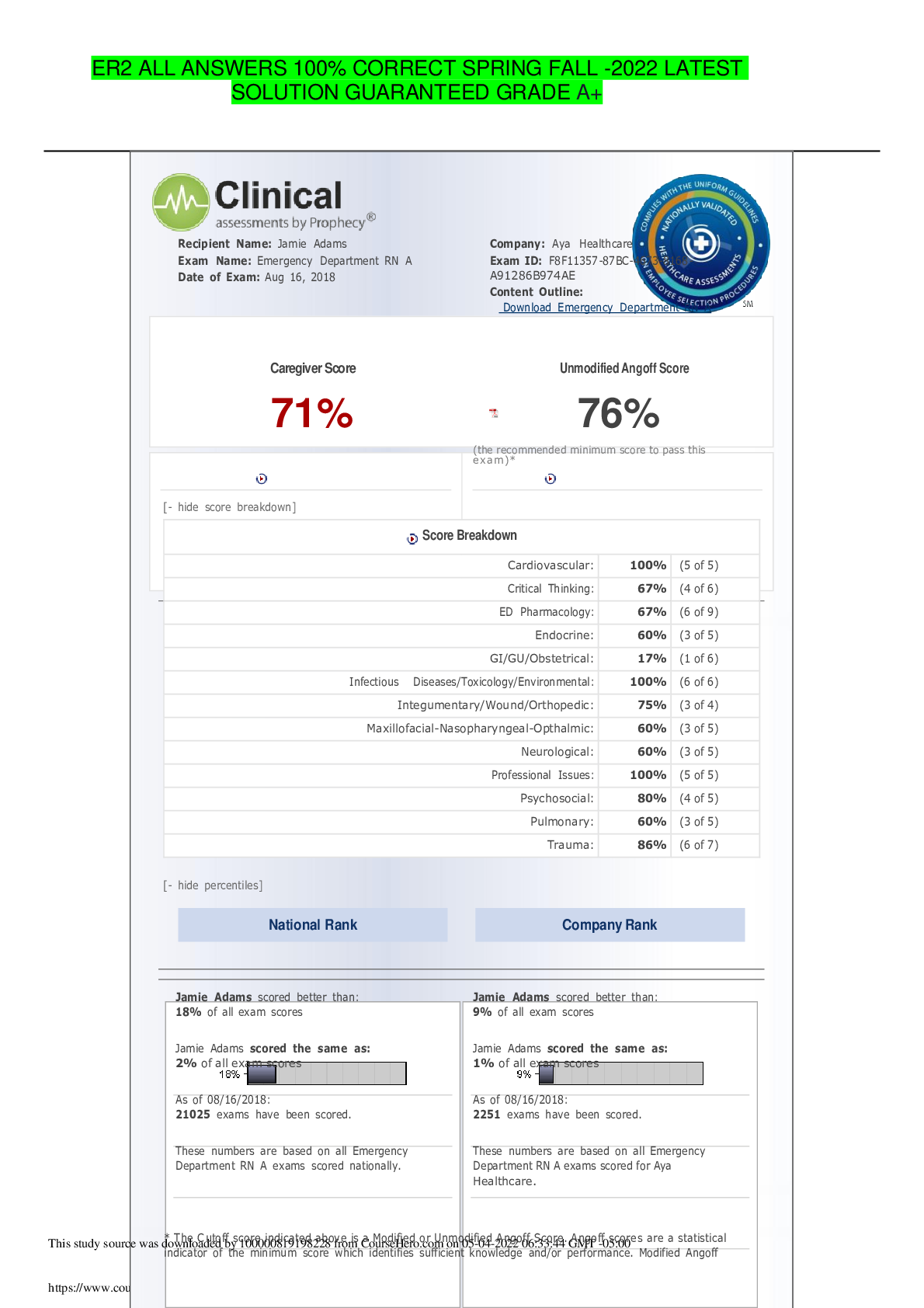



.png)
.png)

